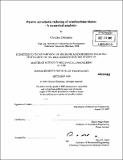| dc.contributor.advisor | Klaus-Jürgen Bathe. | en_US |
| dc.contributor.author | Deilmann, Christian | en_US |
| dc.contributor.other | Massachusetts Institute of Technology. Dept. of Mechanical Engineering. | en_US |
| dc.date.accessioned | 2010-05-25T21:12:27Z | |
| dc.date.available | 2010-05-25T21:12:27Z | |
| dc.date.copyright | 2009 | en_US |
| dc.date.issued | 2009 | en_US |
| dc.identifier.uri | http://hdl.handle.net/1721.1/55266 | |
| dc.description | Thesis (S.M.)--Massachusetts Institute of Technology, Dept. of Mechanical Engineering, 2009. | en_US |
| dc.description | Cataloged from PDF version of thesis. | en_US |
| dc.description | Includes bibliographical references (p. 75-76). | en_US |
| dc.description.abstract | This research aims to have an impact towards a sustainable energy supply. In wind power generation losses occur at tip speed ratios which the rotor was not designed for. Since the ideal blade shape changes nonlinearly with rising wind speeds currently used pitch control mechanisms can only approach the ideal blade deformation. However aeroelastic effects, which cause additional deformation, are almost unavoidable in flexible blade design and it is desirable to tailor these effects to our advantage by a controlled use of orthotropic material properties and a smart design of the blade structure. The idea of systematic aeroelastic tailoring is not new but research has not yet solved the design challenge partly due to the lack of accurate simulation tools. Passively adaptive rotor blades would enable systematic aeroelastic tailoring and have the potential to reduce the cost of energy by around 6% [1]. Within this thesis a design procedure for passively adaptive rotor blades has been developed. It consists of an aerodynamic simulation and optimization code (based on Blade Element Momentum Theory), a structural simulation (based on Finite Element Analysis) and a fluid structure interaction correction loop (based on CFD and FEM). Using the developed design code passively adaptive rotor blades have been designed for the NREL phase VI test turbine. The results show that an ideal passively adaptive blade could improve the efficiency of the test turbine by 3% to 6%. | en_US |
| dc.description.abstract | (cont.) The proposed rotor designs can only approach these improvements. However they do improve the efficiency and since the design only requires a precisely calculated stacking of composite material layers, the cost for manufacturing will not increase significantly. This work is a contribution to solve the design challenge of passively adaptive rotor blades and further research may be based on it. | en_US |
| dc.description.statementofresponsibility | by Christian Deilmann. | en_US |
| dc.format.extent | 76 p. | en_US |
| dc.language.iso | eng | en_US |
| dc.publisher | Massachusetts Institute of Technology | en_US |
| dc.rights | M.I.T. theses are protected by
copyright. They may be viewed from this source for any purpose, but
reproduction or distribution in any format is prohibited without written
permission. See provided URL for inquiries about permission. | en_US |
| dc.rights.uri | http://dspace.mit.edu/handle/1721.1/7582 | en_US |
| dc.subject | Mechanical Engineering. | en_US |
| dc.title | Passive aeroelastic tailoring of wind turbine blades : a numerical analysis | en_US |
| dc.type | Thesis | en_US |
| dc.description.degree | S.M. | en_US |
| dc.contributor.department | Massachusetts Institute of Technology. Department of Mechanical Engineering | |
| dc.identifier.oclc | 613206651 | en_US |
